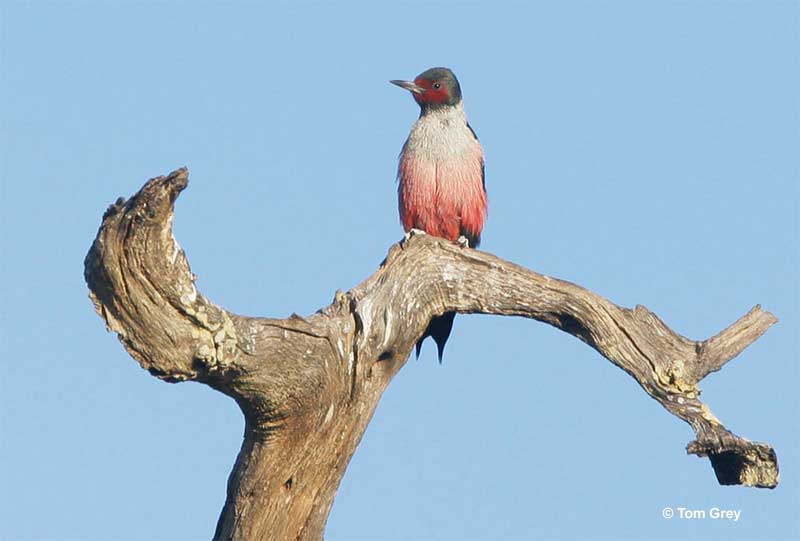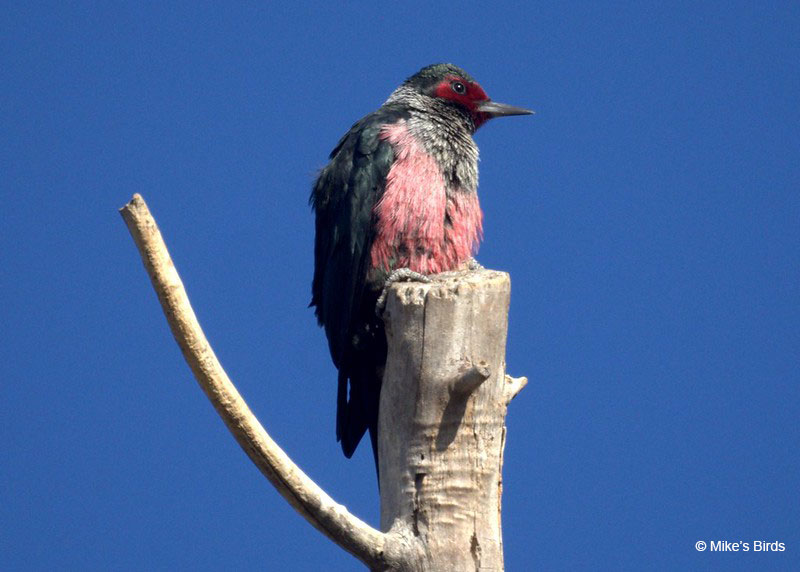Lewis’s Woodpeckers (Melanerpes lewis) are rather unique. They have striking black-and-red plumage, fly like crows, and hunt insects like flycatchers. Their bills are thinner than most other woodpeckers’ and they do not excavate their own nesting cavities.
Here is everything you need to know about them and some fun facts as an extra!
Identification
Lewis’s Woodpeckers are medium-sized woodpeckers, measuring 10-11 inches long with a wingspan of 19.3-20.5 inches. Their bodies are stocky and look elongated. They have long and broad wings and a medium-length but very strong tail that they use to support themselves while climbing along tree trunks.
What makes them unique is that even though they are and look like woodpeckers in shape, then they forage like flycatchers and fly like crows with deep wingbeats and glides.
Male and female Lewis’s Woodpeckers look the same. They appear dark overall, especially when viewed from a distance, but in good light or upon closer inspection, you can see that they are actually painted in deep black, vibrant red, and gray.

Their back, wings, and tail are black which appears dark iridescent green in good light. The head is black with a dark red face. They have a gray collar around their neck, separating the body from the head. Their bellies have a pinkish-red wash and their chest is gray. They have dark eyes and a black, relatively thin bill for a woodpecker.
Juvenile Lewis’s Woodpeckers are darker than adults and lack the gray collar adults have. They are brownish-black above, have a black head, and have dark gray undersides with a reddish tinge.
Vocalizations
Lewis’s Woodpeckers are generally silent and mainly vocalize during the breeding season. Their call is a harsh scolding churr, given 3-8 times in a row. They mostly do that during the courtship phase. Throughout the year, both sexes use harsh squeaks to communicate, often given in series.
Lewis’s Woodpecker’s drums are quiet and regular and done as a part of the courtship ritual. However, it can sometimes start or end with a few extra knocks, making it sound irregular and resemble sapsucker’s drumming.
Food
Lewis’s Woodpeckers are omnivorous, but their specific diet varies depending on the season. During the spring and summer, while they are breeding, they are mainly insectivorous; in fall and winter, they eat more plant matter.
The animal part of their diet includes various insects like ants, crickets, mayflies, and grasshoppers, whereas the plant part of their diet is made up of nuts and berries such as acorns, pine nuts, juniper berries, apricots, and cherries.

Lewis’s Woodpeckers forage like other woodpeckers, climbing up and down trees and picking insects from branches or tree trunks. However, they do not probe the trees for insects under the bark and are often seen perching perpendicularly on branches, wires, and posts, which the other woodpeckers typically do not do.
They then dart out from these perches to catch insects mid-air. Their exceptional vision allows them to spot insects from considerable distances – up to about 100 feet away! They may also circle high in the air and then swoop down to catch insects below them.
However, as the seasons shift to fall, their dietary habits change. They turn their attention to harvesting nuts, mainly acorns. Using their powerful bills, they crack these nuts into bite-sized pieces and then store them in bark crevices or tree holes for the winter.
Nesting and Eggs
Lewis’s Woodpeckers are monogamous, and pairs may even mate for life. Males try to attract a mate by fluttering around the nest tree and calling. Other courtship or aggression displays include birds perching with their wings spread, neck feathers raised, and heads lowered.
Lewis’s Woodpeckers nest in cavities in dead or decaying trees, occasionally also living trees from 5 to 60 feet above the ground on average. Favorite nesting tree species include cottonwood, birch, and several pine species.
They rarely excavate their own holes, opting for naturally formed ones or those created by other cavity-nesting birds. However, they may modify existing cavities and line the bottom with wood chips. The nesting site is chosen by the male and the pair often returns to the same one year after year.
One pair raises one brood per year with 4-9, usually 6-7 eggs in a clutch. Lewis’s Woodpecker eggs are white and measure 0.9-1.2 inches long and 0.7-0.9 inches wide. Incubation takes 12-16 days, with males incubating at night and females during the day.
Both parents feed and care for their offspring. The younglings leave the nest 4-5 weeks after hatching but remain with their parents for a while before gaining full independence.
Current Situation
Lewis’s Woodpeckers range throughout the western United States with their northernmost range extending into British Columbia in Canada.
Their breeding range covers most of the northwestern United States and their wintering range the southwestern United States. Individuals in the northern areas migrate south for the winter whereas birds in the south may stay put year-round unless they need to find new sources of food.
Lewis’s Woodpeckers prefer to live in logged or burned areas rather than in dense forests. For breeding, they seek out old-growth woodlands, particularly favoring open ponderosa pine forests and burned areas with lots of standing dead trees.
They also breed in oak woodlands, orchards, and pinyon-juniper woodlands, particularly those near streams. During the non-breeding season, they are less picky and are more nomadic, looking for wooded areas abundant with food.
Lewis’s Woodpeckers are listed as of least concern on the IUCN Red List. However, they are fairly uncommon, and their population is declining. They need dead or decaying trees for nesting, but forestry practices such as logging, grazing, and fire suppression result in less suitable habitats.
Facts About Lewis Woodpeckers
- Lewis’s Woodpeckers are named after Meriwether Lewis, the first to describe the species.
- Lewis’s Woodpeckers have a habit of caching bits of nuts and seeds for the winter, and they are very protective over them. If another bird enters their territory, they may chatter and put on a display to chase them away. They are especially wary of other woodpeckers.
- Lewis’s Woodpecker is a special case. Unlike most other woodpeckers, they rarely drill into trees to find insects or their larvae. Instead, they either glean them from the bark or sit on perches and fly to catch them in mid-air.
Similar Species
Lewis’s Woodpeckers are unique in appearance and easily identifiable. You are more likely to confuse the juvenile of the species with other woodpeckers, but even that should not be much of a challenge once you get a good look. Here are some similar species and how to tell them apart.
Acorn Woodpecker

Acorn Woodpeckers are resident along the western coast of the United States and in parts of Arizona and New Mexico. Adults are black above, have white underparts with black streaking and a black chest. They have a black head with a white mask around the face. Females have a red nape that extends farther to the front of their head in males. They also have pale whitish eyes.
The two might be mistaken due to their overall dark appearance, but the Acorn Woodpecker lacks red on their undersides and the gray collar whereas Lewis’s Woodpeckers do not have a white face mask or pale eyes.
Black-backed Woodpecker

Black-backed Woodpeckers range throughout most of northern and western North America. They are black above, white below, and have barred flanks. Their head is black with a white streak across their face, a little white mark behind their eye, and a white throat. Males have a yellow cap.
You may mistake a female Black-backed Woodpecker for a juvenile Lewis’s Woodpecker. However, the juvenile is much darker below and does not have any face markings.
Red-breasted Sapsucker

Red-breasted Sapsuckers range along the coast of western North America. Adults are black above with white markings on the back and a white wing patch, pale below with black markings, and have a red head, neck, and chest. Juveniles are dark overall with white markings on the back and wings.
Lewis’s Woodpeckers have black heads, gray collars, and pinkish-red belly, whereas Red-breasted Sapsuckers have a red head and chest and pale undersides marked with black. Juveniles are very similar. However, juvenile Red-breasted Sapsuckers have white markings on their back and wings whereas juvenile Lewis’s Woodpeckers do not.
Frequently Asked Questions
Who are Lewis’s Woodpeckers named after?
Lewis’s Woodpeckers were named in honor of Meriwether Lewis, the American explorer who first saw and described the bird.
Where do Lewis’s Woodpeckers live?
Lewis’s Woodpeckers are found in open or even logged or burned woodlands with lots of standing dead trees in western North America.
Do Lewis’s Woodpeckers migrate?
Those Lewis’s Woodpeckers that breed throughout the northern parts of the range migrate southward for winter. Some populations are resident year-round in the south.

